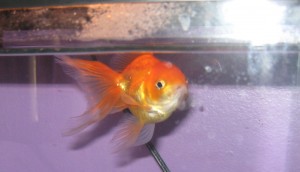Think of the inexorably strong force of a whirl pool. If it has enough power, the vortex will pull anything from the surface of the water and plunge it beneath. It is inevitable that vacuums will be filled.

I don’t really know about the physics of black holes, tornadoes or any other sort of naturally occurring vacuum. But I have seen this in action in human interaction. Read more…
joebouchard Assessing the organization, Self Scrutiny, Staff relations
There once was a big fish in a little tank. She had her fill of all food, eating first and as much as she wanted. Life was good for this particular fish, as she lorded over all that she saw. All of the other fish gave her plenty of room whenever she swam by. All creatures in her world respected and/or feared her.

Then one day – and without warning – the inevitable waves of change introduced a new fish to the tank. Read more…
joebouchard Assessing the organization, Self Scrutiny, Staff relations
|
Although time recedes from the horrible events of 9/11/2001, the lessons remain relevant. We in corrections are always watchful.
The events of September 11, 2001 forced all Americans to think about what was previously inconceivable in the minds of most. Mainland America was attacked by foreign agents. In a way, our nation lost its comfortable innocence and geographical insulation on one Tuesday morning six years ago. However, unlike the majority of Americans, corrections staff were a bit more prepared to understand this. And that is due to our training and on-the-job experience. Read more… |
joebouchard Assessing the organization, Training
There is no doubt that corrections professionals perform a very important job. Every moment we are inside the walls, we face potential danger from many directions. Some of these are obvious while others are unobtrusive. We are responsible to keep ourselves and inmates safe. In addition, when we consider whom we are really working for, we need to consider the general public.
 We understand the nuts and bolts of what we do on a daily basis. But how often do we see the higher purpose to our vocation?
We understand the nuts and bolts of what we do on a daily basis. But how often do we see the higher purpose to our vocation?
Read more…
joebouchard Assessing the organization
A colleague from Virginia recently imparted some vocational wisdom. (We’ll call him Lt. J.) One of Lt. J’s many professional functions is as a training coordinator for four jails. The point that Lt. J made was “it is easy to underestimate someone based on stereotypes or limited information.” And this is how it came up.
He and I put together a module on staff relations. On the maiden voyage of this training, Lt. J mentioned to the class that the initial author (yours truly) also works as a prison librarian. The job title evoked some groans from the audience. Lt. J discovered that the common sentiment was “what would a librarian know about anything?”

This is a classic example of underestimation or judging a book by its cover.
Read more…
joebouchard Assessing the organization, Self Scrutiny, Staff relations
Imagine that you are disoriented in thick and impenetrable woods. You have no idea how to find your way out. You are without a GPS, cell phone, flare, and the most basic tool to help with one’s bearings: the compass. Without those tools, can you imagine the helplessness of not knowing where to go?
In departmental communications, like in finding our way out of the forest, a compass will not work unless all points are present.

If we do not know where we are and where we are going, we are effectively lost. Do we always have our bearings in the realm of information exchange? Our jobs would be much easier if we had a communications compass.
It has been said that communications is a two-way street. Certainly, we benefit from data sharing between two parties rather than a one-way lecture. Listening and talking are complementary actions with equal weight. It is not so simple, though. In fact, the two-way street of information exchange can be expanded into four points on a compass.
Read more…
joebouchard Assessing the organization, Staff relations
Author’s note: The term “rat” has connotations of snitching and telling on others. For the purposes of this essay, rat is not used in that particular sense.
What a mess! They scrambled, jockeyed, and positioned themselves for the best pickings. It was a veritable grab for the best positions. Cynically speaking, ambition sometimes leaves us looking like starving rats at a buffet – driven by maddening avarice and hunger.
Imagine that the buffet is a metaphor for resources. Read more…
joebouchard Assessing the organization
In part I of lurking beneath the surface we asked the question “Are things always as they seem?” The appearance of superficial surprises can mask horrifying dangers. There often is something lurking beneath the surface. Some of these unobtrusive menaces are our own mistakes, outside changes, contraband, staff division, and prisoner uprisings. The perfect cup of coffee is perfect only as long as one does not find a dead insect floating on the surface.
What we do to cope with these things? How can we combat the danger of the shark that surfaces on hitherto placid water? Read more…
joebouchard Assessing the organization
AH! It could not have been more perfect. Without a doubt that was the best cappuccino that I have ever had. The texture, the taste, the aroma, it was all optimal. Little did I know that floating in a cavalier manner on my dream drink was a gnat. So much for perfection!

So often, we are absorbed by the rightness of a moment only to find some flaw that totally alters our perceptions of wellbeing. It is true that we corrections professionals are trained to look beyond what we see with the naked eye. Still, we are human and we can be fooled.
Are things always as they seem? The appearance of superficial surprises can suggest horrifying dangers. There often is something lurking beneath the surface. Read more…
joebouchard Assessing the organization
One does not have to be a farmer to grasp this fact: It is not easy to grow crops. Often the cultivator is at the mercy of the environment. But even in good years, the wise farmer will apply the proper measure of sun, water, weeding and fertilizer. Those who let nature take its course will usually gather a lesser harvest.
“Nip it in the bud” is a phrase that comes to us from our agricultural history. It is used in modern terminology to describe how one should tend to a potentially bad situation before it grows unmanageably large and wild.

Avoidance management happens frequently and in many forms. It comes from any combination of interactions. Avoidance management happens between staff, involving prisoner interactions, and from staff to prisoner. Read more…
joebouchard Assessing the organization, Staff relations








